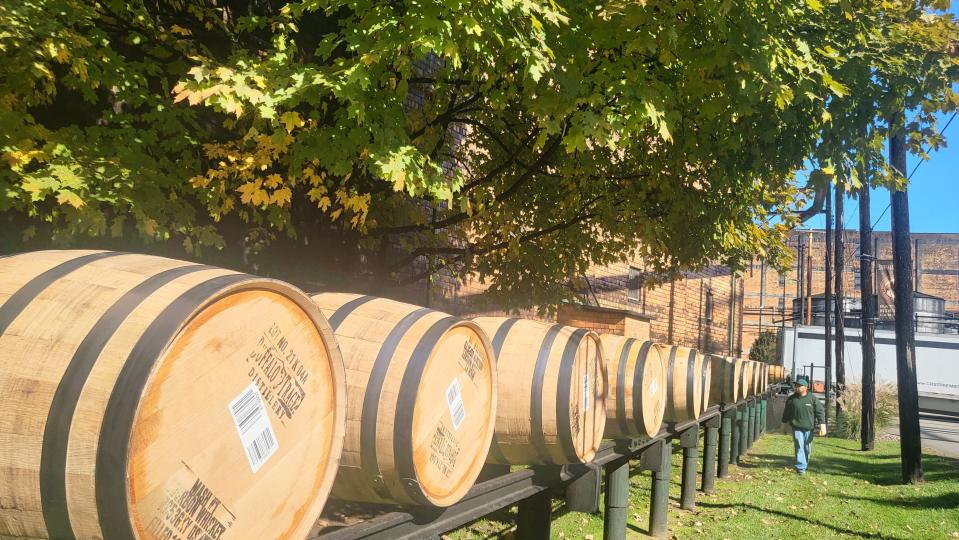The Buffalo Trace amendment to warehouse bourbon is a hazard to community safety: Opinion
On Nov.10, Franklin County/City Planning and Zoning Commissioners will vote on Buffalo Trace's Zoning Code Amendment which exempts Buffalo Trace from the City/County Comprehensive Development Plan building guidelines and allows them and any other distillery to build bourbon warehouses on any 100 acre rural residential or agricultural land they can buy in Franklin County without any restrictions or chance for people to object.
The major problem with the amendment is federal and state building/fire codes for bourbon warehouses are minimum requirements and do not address all the safety needs as bourbon warehouse construction moves into urban areas. While local governments can add conditions that are more stringent, if the Buffalo Trace Amendment is passed local jurisdictions will not be able to require any building regulations over and above federal or state building codes.

More:Big changes are in store for Daniel Boone National Forest. Why conservationists are worried
Consider the following conversation from the article, "Fire Protection in Kentucky Bourbon's New Urban Interface."
Austin Grant, PE: "I think engineers and owners need to understand that meeting building code is a very minimum requirement, and with new distilleries going into urban settings, the building code cannot address all situations."
Brad Emerick PE, CBO, CFCO: "If you want to see a spectacular example of why they’re needed, search for videos of Heaven Hills distillery. The rivers of fire are ignited whiskey. I don’t know if it’s nostalgic affinity for American whiskey, but the fact it's a flammable liquid is often overlooked. There has to be vigilance in balancing safety with familiarity. For example, consider there's a proposal to modify the 2021 International Building and Fire Codes to down-classify barrel storage warehouses of any size to "moderate" hazard storage from [high] hazardous storage referenced in your article. Can you imagine even a quarter-scale version of Heaven Hills’ misfortune in an urban setting if this is adopted in code?
Melvin Stanbrough: " And this change in code is based on $$$ savings but not the hazard being addressed."
Much has changed since the first Kentucky State Building Codes for bourbon warehouses were written in 2010. Extreme weather events are more frequent. The warehouses are bigger, hold more alcohol and weigh more. Warehouse are being built closer to urban areas adding to the risk of fires spreading into them. Current state and federal building/fire codes don't address these changes. Thankfully, local governments can add more stringent building requirements than the state and federal codes.
For example, bourbon warehouse collapse is a major cause of fire and environmental catastrophes and according to University of Kentucky. Geological Survey should NOT be built on karst land riddled with sinkhole like the Peaks Mill site. "Structures built above voids (sinkholes) can experience significant settlement and extensive structural damage...cause catastrophic failures of the structure, and endanger the public." (Think entire cars swallowed by sinkhole at the Corvette Museum showroom in Bowling Green)
University of Kentucky geologists strenuously recommend that before a building site on karst land is approved, tests should be completed for locating sinkholes and engineering studies that determine the efficacy of building large warehouses on land with sinkholes. The Peaks Mill site will have to support seventeen, 15,500 ton warehouses holding 51 million gal. of highly combustible alcohol. Yet, Buffalo Trace did not do the tests because federal and state regulations did not require them. Fortunately, Planning and Zoning could require the tests. (They haven't yet).
When evaluating fire codes, its important to remember that one Buffalo Trace bourbon warehouse is the size of a 7 story football field, weighs 15,500 tons and holds three million gallons of highly combustible alcohol. It is not a barn as Buffalo Trace maintains; it is an incendiary bomb waiting for a lightning strike, a machinery spark or a collapsed warehouse to ignite it. The incidence rate for a bourbon disaster is once every 3.5 years. It's not a matter of if there will be an environmental catastrophes; its matter of when.
More:Are fish from Kentucky lakes, rivers safe to eat? New state guidance details the risk.
Bourbon warehouse fires are hard to extinguish and contain. One bourbon warehouse burned for three days in Versailles. The fire leaped 100 feet in the air, melted the plastic headlights on the fire engine and took 75 firemen from five counties to contain the blaze. Special equipment was needed (i.e. trucks that shoot foam instead of water) The alcohol spill polluted 85 miles of Glenn's Creek and the Kentucky River, killing thousands of fish and contaminating drinking water.
If Buffalo Trace's amendment is passed, Planning and Zoning cannot require any conditions and Buffalo Trace only has to do the very minimum federal and state building/fire code requirements. Buffalo Trace has dealt with warehouse fires before. They know firsthand the dangers to the community but evidently aren't willing to take any responsibility or protective measures beyond the minimal state and federal building codes, hence their amendment. My guess is Buffalo Trace figures it's cheaper to build with minimum code requirements and then pay fines when the environmental catastrophe happens, forget the cost and risk to its neighbors or the environment.
Margaret Groves is a former Franklin County teacher. She retired after 30 years from the Department of Education. She's lived in Franklin County for 23years. Her home is a stones throw from Buffalo Trace.
This article originally appeared on Louisville Courier Journal: Buffalo Trace amendment to warehouse bourbon is a hazard to community

